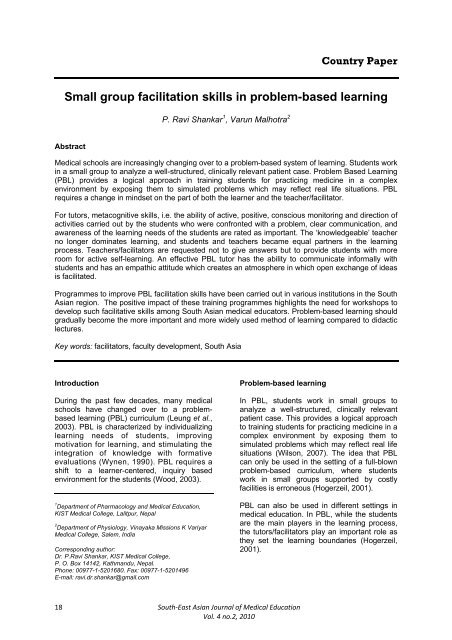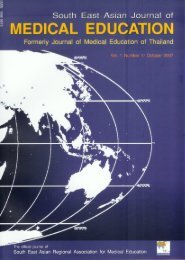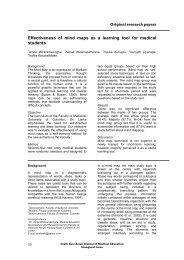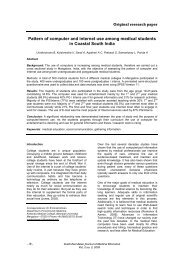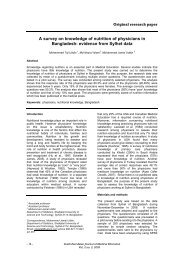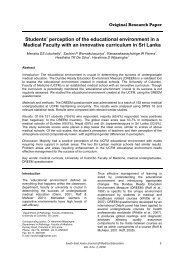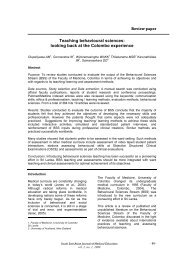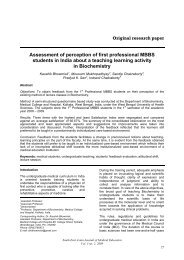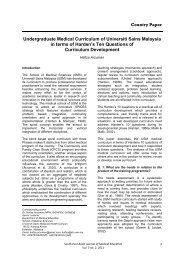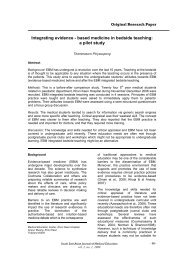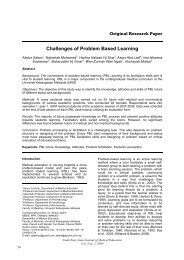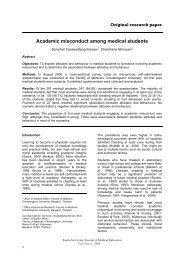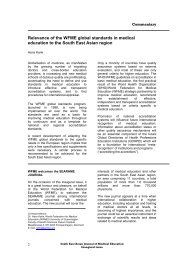Small group facilitation skills in problem-based learning - South East ...
Small group facilitation skills in problem-based learning - South East ...
Small group facilitation skills in problem-based learning - South East ...
You also want an ePaper? Increase the reach of your titles
YUMPU automatically turns print PDFs into web optimized ePapers that Google loves.
Country Paper<br />
<strong>Small</strong> <strong>group</strong> <strong>facilitation</strong> <strong>skills</strong> <strong>in</strong> <strong>problem</strong>-<strong>based</strong> learn<strong>in</strong>g<br />
P. Ravi Shankar 1 , Varun Malhotra 2<br />
Abstract<br />
Medical schools are <strong>in</strong>creas<strong>in</strong>gly chang<strong>in</strong>g over to a <strong>problem</strong>-<strong>based</strong> system of learn<strong>in</strong>g. Students work<br />
<strong>in</strong> a small <strong>group</strong> to analyze a well-structured, cl<strong>in</strong>ically relevant patient case. Problem Based Learn<strong>in</strong>g<br />
(PBL) provides a logical approach <strong>in</strong> tra<strong>in</strong><strong>in</strong>g students for practic<strong>in</strong>g medic<strong>in</strong>e <strong>in</strong> a complex<br />
environment by expos<strong>in</strong>g them to simulated <strong>problem</strong>s which may reflect real life situations. PBL<br />
requires a change <strong>in</strong> m<strong>in</strong>dset on the part of both the learner and the teacher/facilitator.<br />
For tutors, metacognitive <strong>skills</strong>, i.e. the ability of active, positive, conscious monitor<strong>in</strong>g and direction of<br />
activities carried out by the students who were confronted with a <strong>problem</strong>, clear communication, and<br />
awareness of the learn<strong>in</strong>g needs of the students are rated as important. The ‘knowledgeable’ teacher<br />
no longer dom<strong>in</strong>ates learn<strong>in</strong>g, and students and teachers became equal partners <strong>in</strong> the learn<strong>in</strong>g<br />
process. Teachers/facilitators are requested not to give answers but to provide students with more<br />
room for active self-learn<strong>in</strong>g. An effective PBL tutor has the ability to communicate <strong>in</strong>formally with<br />
students and has an empathic attitude which creates an atmosphere <strong>in</strong> which open exchange of ideas<br />
is facilitated.<br />
Programmes to improve PBL <strong>facilitation</strong> <strong>skills</strong> have been carried out <strong>in</strong> various <strong>in</strong>stitutions <strong>in</strong> the <strong>South</strong><br />
Asian region. The positive impact of these tra<strong>in</strong><strong>in</strong>g programmes highlights the need for workshops to<br />
develop such facilitative <strong>skills</strong> among <strong>South</strong> Asian medical educators. Problem-<strong>based</strong> learn<strong>in</strong>g should<br />
gradually become the more important and more widely used method of learn<strong>in</strong>g compared to didactic<br />
lectures.<br />
Key words: facilitators, faculty development, <strong>South</strong> Asia<br />
Introduction<br />
Dur<strong>in</strong>g the past few decades, many medical<br />
schools have changed over to a <strong>problem</strong><strong>based</strong><br />
learn<strong>in</strong>g (PBL) curriculum (Leung et al.,<br />
2003). PBL is characterized by <strong>in</strong>dividualiz<strong>in</strong>g<br />
learn<strong>in</strong>g needs of students, improv<strong>in</strong>g<br />
motivation for learn<strong>in</strong>g, and stimulat<strong>in</strong>g the<br />
<strong>in</strong>tegration of knowledge with formative<br />
evaluations (Wynen, 1990). PBL requires a<br />
shift to a learner-centered, <strong>in</strong>quiry <strong>based</strong><br />
environment for the students (Wood, 2003).<br />
1<br />
Department of Pharmacology and Medical Education,<br />
KIST Medical College, Lalitpur, Nepal<br />
2<br />
Department of Physiology, V<strong>in</strong>ayaka Missions K Variyar<br />
Medical College, Salem, India<br />
Correspond<strong>in</strong>g author:<br />
Dr. P.Ravi Shankar, KIST Medical College,<br />
P. O. Box 14142, Kathmandu, Nepal.<br />
Phone: 00977-1-5201680. Fax: 00977-1-5201496<br />
E-mail: ravi.dr.shankar@gmail.com<br />
Problem-<strong>based</strong> learn<strong>in</strong>g<br />
In PBL, students work <strong>in</strong> small <strong>group</strong>s to<br />
analyze a well-structured, cl<strong>in</strong>ically relevant<br />
patient case. This provides a logical approach<br />
to tra<strong>in</strong><strong>in</strong>g students for practic<strong>in</strong>g medic<strong>in</strong>e <strong>in</strong> a<br />
complex environment by expos<strong>in</strong>g them to<br />
simulated <strong>problem</strong>s which may reflect real life<br />
situations (Wilson, 2007). The idea that PBL<br />
can only be used <strong>in</strong> the sett<strong>in</strong>g of a full-blown<br />
<strong>problem</strong>-<strong>based</strong> curriculum, where students<br />
work <strong>in</strong> small <strong>group</strong>s supported by costly<br />
facilities is erroneous (Hogerzeil, 2001).<br />
PBL can also be used <strong>in</strong> different sett<strong>in</strong>gs <strong>in</strong><br />
medical education. In PBL, while the students<br />
are the ma<strong>in</strong> players <strong>in</strong> the learn<strong>in</strong>g process,<br />
the tutors/facilitators play an important role as<br />
they set the learn<strong>in</strong>g boundaries (Hogerzeil,<br />
2001).<br />
18<br />
<strong>South</strong>‐<strong>East</strong> Asian Journal of Medical Education<br />
Vol. 4 no.2, 2010
Change <strong>in</strong> m<strong>in</strong>dset<br />
PBL requires a change <strong>in</strong> m<strong>in</strong>dset on the part<br />
of both the learner and the teacher/facilitator.<br />
Students need to be aware of the role of the<br />
tutor and should not expect a situation where<br />
the facilitator determ<strong>in</strong>es what should be<br />
learned, to what depth, and <strong>in</strong> what sequence<br />
(Das et al., 2002). In a study on student<br />
perceptions of tutor <strong>skills</strong> <strong>in</strong> PBLs,<br />
metacognitive <strong>skills</strong> of the tutor, i.e. the ability to<br />
carry out active, positive, conscious<br />
monitor<strong>in</strong>g and direction of the reason<strong>in</strong>g<br />
activities of students who were confronted<br />
with the <strong>problem</strong> were rated as important<br />
(Das et al., 2002). Clear communication<br />
and awareness of the learn<strong>in</strong>g needs of the<br />
students are also important tutor <strong>skills</strong> <strong>in</strong> PBL<br />
<strong>facilitation</strong>. Students were often unable to<br />
identify their learn<strong>in</strong>g needs and the depth of<br />
study required and this made them<br />
uncomfortable <strong>in</strong> a PBL curriculum (Woodward<br />
& Ferrier, 1982). The tutors may need to<br />
address this issue.<br />
The role of the teacher<br />
PBL requires a major shift <strong>in</strong> the way teachers<br />
deal with students, The ‘knowledgeable’<br />
teacher is no longer dom<strong>in</strong>at<strong>in</strong>g learn<strong>in</strong>g and<br />
students and teachers become equal partners<br />
<strong>in</strong> the learn<strong>in</strong>g process. The teacher stops<br />
lectur<strong>in</strong>g and starts ask<strong>in</strong>g questions<br />
(Hogerzeil, 2001). In a PBL course, teachers<br />
should encourage critical th<strong>in</strong>k<strong>in</strong>g, foster selfdirected<br />
learn<strong>in</strong>g and curiosity, monitor <strong>group</strong><br />
progress, promote teamwork and create<br />
conducive learn<strong>in</strong>g environment (Wilkerson,<br />
1998).<br />
Skills required for the teacher/facilitator<br />
Facilitation <strong>in</strong> PBL requires a different set of<br />
<strong>skills</strong> on the part of the teacher/facilitator. A<br />
recent work has identified the twelve qualities<br />
of a good teacher or mentor (Azer, 2005).<br />
These <strong>in</strong>clude; he/she is committed to the<br />
work, encourages and appreciates diversity,<br />
<strong>in</strong>teracts and communicates respect,<br />
motivates students and co-workers, br<strong>in</strong>gs a<br />
wide range of <strong>skills</strong> and talents to teach<strong>in</strong>g and<br />
demonstrates leadership <strong>in</strong> teach<strong>in</strong>g,<br />
encourages creative work, emphasizes<br />
teamwork, seeks to cont<strong>in</strong>ually improve<br />
teach<strong>in</strong>g <strong>skills</strong> and provides positive feedback<br />
(Azer, 2005). Six important roles a medical<br />
teacher must also engage <strong>in</strong> are the roles of<br />
the <strong>in</strong>formation provider, the role model, the<br />
mentor and learn<strong>in</strong>g facilitator, the student<br />
assessor and curriculum evaluator, the<br />
curriculum and course planner and the<br />
resource material creator (Harden & Crosby,<br />
2000). Some teachers may be more proficient<br />
<strong>in</strong> some roles than <strong>in</strong> others.<br />
Practical h<strong>in</strong>ts for <strong>problem</strong>-<strong>based</strong> learn<strong>in</strong>g<br />
The Teacher’s Guide to Good Prescrib<strong>in</strong>g lists<br />
practical h<strong>in</strong>ts for <strong>problem</strong>-<strong>based</strong> learn<strong>in</strong>g and<br />
teach<strong>in</strong>g (Hogerzeil, 2001). Some of these are,<br />
start<strong>in</strong>g the session by def<strong>in</strong><strong>in</strong>g one s<strong>in</strong>gle<br />
<strong>problem</strong> and mak<strong>in</strong>g sure that everyone<br />
understood it; avoid<strong>in</strong>g <strong>in</strong>terference with the<br />
<strong>group</strong> dur<strong>in</strong>g the first ten m<strong>in</strong>utes of the<br />
session and consider<strong>in</strong>g <strong>in</strong>terventions only to<br />
<strong>in</strong>fluence the <strong>group</strong> process. The PBL<br />
facilitator should guide the learn<strong>in</strong>g process of<br />
the <strong>group</strong> by prob<strong>in</strong>g, prompt<strong>in</strong>g and<br />
question<strong>in</strong>g (L<strong>in</strong>g et al., 2007). He/she is to<br />
assist the <strong>group</strong> processes to ensure that the<br />
<strong>group</strong> <strong>in</strong>teracts well and ma<strong>in</strong>ta<strong>in</strong>s focus. One<br />
study shows that students prefer facilitators to<br />
expla<strong>in</strong> unclear facts and to correct them when<br />
facts are wrong (Yee et al., 2006).<br />
As already stated <strong>in</strong> PBL, teachers/facilitators<br />
are requested not to give answers but to<br />
provide students with more room for active<br />
self-learn<strong>in</strong>g (Leung et al., 2003). A PBL tutor<br />
may take the roles of a parent, a professional<br />
consultant, a confidant, a learner and a<br />
mediator (Wilkerson & Hundert, 1991). A PBL<br />
facilitator should have expertise <strong>in</strong> <strong>group</strong><br />
<strong>facilitation</strong> <strong>skills</strong> and is the custodian of the<br />
<strong>group</strong> process and the guide for discovery.<br />
The ideal tutor does not rema<strong>in</strong> silent<br />
regardless of the subject matter of the PBL.<br />
The tutor must know when to <strong>in</strong>terject or <strong>in</strong>tervene<br />
and when to hold back and participate equally<br />
with the students (Wetzel, 1996).<br />
An effective PBL tutor<br />
An effective PBL tutor should have the ability<br />
to communicate <strong>in</strong>formally with students and<br />
an empathic attitude which enables an<br />
atmosphere to be created <strong>in</strong> which open<br />
exchange of ideas is facilitated (Schmidt &<br />
Moust, 1995). Bibace and coworkers classified<br />
teachers’ verbal behaviours under four styles:<br />
assertive, suggestive, collaborative and<br />
facilitative. These styles are along a cont<strong>in</strong>uum<br />
with the most student-centered (facilitative) style<br />
at one end and the most teacher-centered<br />
(assertive) style at the other (Bibace et al., 1981).<br />
Collaborative and facilitative teach<strong>in</strong>g styles<br />
are ideal <strong>in</strong> a PBL tutorial. Medical students<br />
respond warmly to positive stimuli, and react<br />
by withdrawal and defensive attitudes to<br />
negative environments (Bligh, 2003). The<br />
<strong>South</strong>‐<strong>East</strong> Asian Journal of Medical Education<br />
Vol. 4 no.2, 2010<br />
19
teacher has the responsibility to establish an<br />
environment that encourages learn<strong>in</strong>g.<br />
Faculty development programmes<br />
Faculty development programmes have<br />
received less priority <strong>in</strong> <strong>South</strong> Asia. In India,<br />
National Teachers’ Tra<strong>in</strong><strong>in</strong>g Centers (NTTCs)<br />
conduct tra<strong>in</strong><strong>in</strong>g programmes for medical<br />
teachers (Bansal & Supe, 2007).<br />
These programmes are held over a ten<br />
day period and cover areas such<br />
as educational objectives, educational<br />
methods, media, assessment methods and<br />
curriculum plann<strong>in</strong>g. Such programmes may<br />
be <strong>in</strong>adequate for the number of teachers and<br />
certa<strong>in</strong> private medical <strong>in</strong>stitutions <strong>in</strong> India<br />
have developed l<strong>in</strong>ks with <strong>in</strong>ternational<br />
medical schools.<br />
The FAIMER Institute<br />
The Foundation for Advancement of<br />
International Medical Education and Research<br />
(FAIMER) <strong>in</strong>stitute is a two-year fellowship<br />
programme which has been designed for<br />
medical school faculty from develop<strong>in</strong>g<br />
countries (Norc<strong>in</strong>i et al., 2005). The<br />
programme is designed to teach educational<br />
methods and leadership <strong>skills</strong> and to develop<br />
strong professional bonds with other medical<br />
educators. A community of medical educators<br />
is be<strong>in</strong>g created <strong>in</strong> many develop<strong>in</strong>g countries<br />
and retention of physicians may be promoted<br />
(Burdick et al., 2006). FAIMER stresses <strong>skills</strong><br />
necessary to be a successful PBL facilitator.<br />
Facilitator tra<strong>in</strong><strong>in</strong>g workshops <strong>in</strong> developed<br />
nations<br />
In the United States, a one-day workshop<br />
consist<strong>in</strong>g of five small <strong>group</strong> sessions with<br />
two facilitators was used to tra<strong>in</strong> faculty <strong>in</strong><br />
<strong>problem</strong>-centered, learner-focused, small<strong>group</strong><br />
process (PLS) (Crites et al., 2002). The<br />
<strong>in</strong>itial discussion centered on the concepts and<br />
pr<strong>in</strong>ciples related to successful <strong>facilitation</strong><br />
<strong>skills</strong> while the subsequent four small <strong>group</strong>s<br />
re<strong>in</strong>forced these concepts and pr<strong>in</strong>ciples us<strong>in</strong>g<br />
case scenarios and role plays. In Seattle, US a<br />
two-hour faculty development programme was<br />
conducted <strong>in</strong> small <strong>group</strong> <strong>facilitation</strong> (Kim et<br />
al., 2003). Faculty members first shared their<br />
experiences <strong>in</strong> manag<strong>in</strong>g small <strong>group</strong>s and<br />
then engaged <strong>in</strong> role plays <strong>based</strong> on the<br />
scenarios exemplify<strong>in</strong>g challeng<strong>in</strong>g <strong>group</strong><br />
dynamics. The faculty found the role plays<br />
<strong>in</strong>teractive, experiential, comfortable and fun<br />
(Kim et al., 2003).<br />
A three-day course designed for medical<br />
school faculty to promote self-directed<br />
learn<strong>in</strong>g, teach<strong>in</strong>g <strong>skills</strong>, personal awareness<br />
and <strong>in</strong>terdiscipl<strong>in</strong>ary collegiality (Pololi et al.,<br />
2001) was found to be highly effective <strong>in</strong><br />
<strong>in</strong>itiat<strong>in</strong>g a long-term faculty development<br />
programme. The academies of medical<br />
educators at Harvard Medical School (Thibault<br />
et al., 2003) and the University of California,<br />
San Francisco (Cooke et al., 2003) are two<br />
examples of successful tra<strong>in</strong><strong>in</strong>g programmes<br />
for tutor facilitators. In the University of<br />
<strong>South</strong>ern California, School of Dentistry a PBL<br />
process workshop was conducted (Dalrymple<br />
et al., 2007) and learn<strong>in</strong>g theory support<strong>in</strong>g<br />
PBL was <strong>in</strong>troduced and an extended role play<br />
method was used to provide participants with<br />
personal experience of the PBL learn<strong>in</strong>g cycle.<br />
Facilitation <strong>skills</strong> <strong>in</strong> <strong>South</strong> Asia<br />
There have not been many studies on PBL<br />
<strong>facilitation</strong> <strong>skills</strong> <strong>in</strong> <strong>South</strong> Asia. At the BP<br />
Koirala Institute of Health Sciences (BPKIHS)<br />
<strong>in</strong> Dharan, Nepal a three day tra<strong>in</strong><strong>in</strong>g session<br />
for PBL was held for teachers <strong>in</strong> which there<br />
was a significant <strong>in</strong>crease <strong>in</strong> knowledge about<br />
various aspects of PBL follow<strong>in</strong>g the<br />
workshop. Teachers felt the <strong>skills</strong> learnt would<br />
be very useful <strong>in</strong> their work situation (Baral et<br />
al., 2010). At Aga Khan University (AKU) <strong>in</strong><br />
Pakistan, structured small <strong>group</strong> experiential<br />
learn<strong>in</strong>g was used to enhance <strong>skills</strong> <strong>in</strong> PBL<br />
<strong>facilitation</strong> (Sadaf et al., 2009). Participant<br />
feedback was positive and the exercise<br />
provided faculty with an opportunity to practice<br />
<strong>facilitation</strong> <strong>skills</strong> and develop a standard<br />
approach to deal with difficult situations dur<strong>in</strong>g<br />
small <strong>group</strong> dynamics. At AKU, Pakistan<br />
facilitators are a heterogeneous <strong>group</strong> of<br />
<strong>in</strong>dividuals and are <strong>in</strong>troduced to basic<br />
educational pr<strong>in</strong>ciples of PBL and attend<br />
formal <strong>facilitation</strong> tra<strong>in</strong><strong>in</strong>g workshops (Saeed et<br />
al., 2010). The study has shown that recent<br />
medical graduates may be more effective as<br />
facilitators compared to established faculty<br />
members. In attributes such as ask<strong>in</strong>g<br />
appropriate questions, prioritiz<strong>in</strong>g learn<strong>in</strong>g<br />
objectives and identify<strong>in</strong>g misconceptions,<br />
recent graduates performed better than<br />
established faculty. At AKU, <strong>skills</strong> of residents<br />
were compared with faculty members <strong>in</strong><br />
facilitat<strong>in</strong>g PBL sessions (Jafri et al., 2007).<br />
Knowledge Base Content Learn<strong>in</strong>g (KBCL),<br />
PBL, Student Centered Learn<strong>in</strong>g (SCL) and<br />
Group Skills (GS) were assessed. Faculty<br />
showed a greater rat<strong>in</strong>g <strong>in</strong> KBCL and <strong>in</strong> overall<br />
scores. The authors concluded that residents<br />
and postgraduates could be an effective<br />
supplement to faculty members <strong>in</strong> PBL.<br />
20<br />
<strong>South</strong>‐<strong>East</strong> Asian Journal of Medical Education<br />
Vol. 4 no.2, 2010
Lessons for <strong>South</strong> Asia<br />
Workshops to develop <strong>facilitation</strong> <strong>skills</strong> among<br />
<strong>South</strong> Asian medical educators are required.<br />
In <strong>in</strong>stitutions where tra<strong>in</strong><strong>in</strong>g programmes have<br />
been conducted, the sessions were effective <strong>in</strong><br />
improv<strong>in</strong>g <strong>skills</strong> of faculty members and<br />
postgraduates (Baral et al., 2010; Sadaf et al.,<br />
2009; Saeed et al., 2010; Jafri et al., 2007).<br />
Studies to elucidate basel<strong>in</strong>e levels of<br />
<strong>facilitation</strong> <strong>skills</strong> among faculty are also urgently<br />
required. In addition to tra<strong>in</strong><strong>in</strong>g programmes on<br />
PBL and <strong>facilitation</strong>, programmes tailored to<br />
address specific deficiencies noted <strong>in</strong> basel<strong>in</strong>e<br />
studies will also be useful. <strong>Small</strong> <strong>group</strong><br />
learn<strong>in</strong>g us<strong>in</strong>g role plays and other methods<br />
may be ideal to develop such <strong>skills</strong>. Integration<br />
of subjects us<strong>in</strong>g cl<strong>in</strong>ical <strong>problem</strong>s should be<br />
considered. Problem-<strong>based</strong> learn<strong>in</strong>g should<br />
gradually become the more important and the<br />
more widely used method of learn<strong>in</strong>g<br />
compared to didactic lectures.<br />
Encouragement to young medical educators to<br />
become good <strong>problem</strong>-<strong>based</strong> learn<strong>in</strong>g<br />
facilitators should be provided.<br />
References<br />
Azer, S.A. (2005) The qualities of a good teacher:<br />
how can they be acquired and susta<strong>in</strong>ed,<br />
Journal of the Royal Society of Medic<strong>in</strong>e, 98, 2,<br />
pp. 67-69.<br />
Bansal, P. & Supe, A. (2007) Tra<strong>in</strong><strong>in</strong>g of medical<br />
teachers <strong>in</strong> India: need for change, Indian<br />
Journal of Medical Sciences, 61, 8, pp. 478-<br />
484.<br />
Baral, N., Paudel, B.H., Das, BKL, Arval, M.,<br />
Gautam, A. & Lamsal, M. (2010) Prepar<strong>in</strong>g<br />
tutors for <strong>problem</strong>-<strong>based</strong> learn<strong>in</strong>g: An<br />
experience from B. P. Koirala Institute of Health<br />
Sciences, Nepal, Kathmandu University<br />
Medical Journal, 8, pp. 141-145.<br />
Bibace, R., Catl<strong>in</strong>, R.J., Quirk, M.E., Beattie, K.A., &<br />
Slabaugh, R.C. (1981) Teach<strong>in</strong>g styles <strong>in</strong> the<br />
faculty-resident relationship, Journal of Family<br />
Practice, 13, 6, pp. 895-900.<br />
Bligh, J. (2003) The ord<strong>in</strong>ar<strong>in</strong>ess of teach<strong>in</strong>g,<br />
Medical Education, 37, 5, p. 394.<br />
Burdick, W.P., Morahan, P.S. & Norc<strong>in</strong>i, J.J. (2006)<br />
Slow<strong>in</strong>g the bra<strong>in</strong> dra<strong>in</strong>: FAIMER education<br />
programs, Medical Teacher, 28, 7, pp. 631-<br />
634.<br />
Cooke, M., Irby, D.M. & Debas, H.T. (2003) The<br />
UCSF academy of medical education,<br />
Academic Medic<strong>in</strong>e, 78, 7, pp. 666-672.<br />
Crites, G.E., McDonald, S.D. & Markert R.J. (2002)<br />
Teach<strong>in</strong>g EBM <strong>facilitation</strong> us<strong>in</strong>g small <strong>group</strong>s,<br />
Medical Teacher, 24, 4, pp. 442-444.<br />
Dalrymple, K.R., Wuenschell, C., Rosenblum, A.,<br />
Pa<strong>in</strong>e, M., Crowe, D., von Bergmann, H.C.,<br />
Wong, S., Bradford, M.S. & Shuler, C.F. (2007)<br />
PBL core <strong>skills</strong> faculty development workshop<br />
1: An experiential exercise with the PBL<br />
process, Journal of Dental Education, 71, 12,<br />
pp. 249-259.<br />
Das, M., Mpofu, D.J., Hasan, M.Y. & Stewart, T.S.<br />
(2002) Student perceptions of tutor <strong>skills</strong> <strong>in</strong><br />
<strong>problem</strong>-<strong>based</strong> learn<strong>in</strong>g tutorials, Medical<br />
Education, 36, 3, pp. 272-278.<br />
Harden, R.M. & Crosby J. (2000) AMEE Guide no.<br />
20: The good teacher is more than a lecturer –<br />
the twelve roles of the teacher, Medical<br />
Teacher, 22, pp. 334-347.<br />
Hogerzeil, H.V. (ed.) (2001) Teacher’s guide to<br />
good prescrib<strong>in</strong>g, World Health Organization,<br />
Geneva.<br />
Jafri, W., Mumtaz, K., Burdick, W.P., Morahan,<br />
P.S., Freeman, R. & Zehra T. (2007) Improv<strong>in</strong>g<br />
the teach<strong>in</strong>g <strong>skills</strong> of residents as<br />
tutors/facilitators and address<strong>in</strong>g the shortage<br />
of faculty facilitators for PBL modules, BMC<br />
Medical Education, 7, p. 34.<br />
Kim, S., Stevens, N.G. & P<strong>in</strong>sky L. (2003) Cast<strong>in</strong>g<br />
anxiety <strong>in</strong> small <strong>group</strong> <strong>facilitation</strong>: faculty<br />
development via role play, Medical Education,<br />
37, 5, pp. 489.<br />
Leung, K.H., Lue, B.H. & Lee M.B. (2003)<br />
Development of a teach<strong>in</strong>g style <strong>in</strong>ventory for<br />
tutor evaluation <strong>in</strong> <strong>problem</strong>-<strong>based</strong> learn<strong>in</strong>g,<br />
Medical Education, 37, 5, pp. 410-416.<br />
L<strong>in</strong>g, A., Loy, K.J. & Temasek Polytechnic (2007)<br />
Students’ perceptions of good PBL facilitators<br />
[onl<strong>in</strong>e] available at: http://citeseerx.ist.psu.edu<br />
/viewdoc/download%3Fdoi%3D10.1.1.117.272<br />
3% [accessed 8 July 2010].<br />
Norc<strong>in</strong>i, J., Burdick, W. & Morahan P. (2005) The<br />
FAIMER Institute: creat<strong>in</strong>g <strong>in</strong>ternational<br />
networks of medical educators, Medical<br />
Teacher, 27, 3, pp. 214-218.<br />
Pololi, L., Clay, M.C., Lipk<strong>in</strong>, M. Jr., Hewson,<br />
M., Kaplan, C. & Frankel, R.M. (2001)<br />
Reflections on <strong>in</strong>tegrat<strong>in</strong>g theories of adult<br />
education <strong>in</strong>to a medical school faculty<br />
development course, Medical Teacher, 23, 3,<br />
pp. 276-283.<br />
Sadaf, S., Ali, S.K. & Zuberi R.W. (2009) Problem<strong>based</strong><br />
Learn<strong>in</strong>g: Enhanc<strong>in</strong>g Tutors' Facilitation<br />
Skills Us<strong>in</strong>g Structured <strong>Small</strong> Group<br />
Experiential Learn<strong>in</strong>g, Education for Health, 22,<br />
1, p. 96.<br />
<strong>South</strong>‐<strong>East</strong> Asian Journal of Medical Education<br />
Vol. 4 no.2, 2010<br />
21
Saeed, S.A., Zia, N. & Qazi Y. (2010) Facilitation<br />
<strong>skills</strong> of basic sciences faculty and fresh<br />
medical graduates: An AKU experience,<br />
Procedia – Social and Behavioural Sciences, 2,<br />
pp. 1316-1320.<br />
Schmidt, H.G. & Moust J.H. (1995) What makes a<br />
tutor effective A structural-equations model<strong>in</strong>g<br />
approach to learn<strong>in</strong>g <strong>in</strong> <strong>problem</strong>-<strong>based</strong><br />
curricula, Academic Medic<strong>in</strong>e, 70, 8, pp. 708-<br />
714.<br />
Thibault, G.E., Neill, J.M. & Lowenste<strong>in</strong> D.H. (2003)<br />
The academy at Harvard medical school:<br />
nurtur<strong>in</strong>g teach<strong>in</strong>g and stimulat<strong>in</strong>g <strong>in</strong>novation,<br />
Academic Medic<strong>in</strong>e, 78, 7, pp. 673-681.<br />
Wetzel, M.S. (1996) Develop<strong>in</strong>g the role of the<br />
tutor/facilitator, Postgraduate Medical Journal,<br />
vol. 72, 850, pp. 474-477.<br />
Wilkerson, L. & Hundert, E.M. (1991), Becom<strong>in</strong>g a<br />
<strong>problem</strong>-<strong>based</strong> tutor: <strong>in</strong>creas<strong>in</strong>g self-awareness<br />
In: Boud, D. & Feletti G., (eds) The Challenge<br />
of Problem-Based Learn<strong>in</strong>g, New York: St<br />
Mart<strong>in</strong>’s Press, pp. 159–171.<br />
Wilkerson, L. (1998) Tutors and small <strong>group</strong>s <strong>in</strong><br />
<strong>problem</strong>-<strong>based</strong> learn<strong>in</strong>g: lessons from the<br />
curricula, Annals of Internal Medic<strong>in</strong>e, 129, pp.<br />
734-797.<br />
Wilson, J. (2007) Problem-<strong>based</strong> learn<strong>in</strong>g<br />
revolution: Reformation or an empty promise<br />
A review of the constructivist approach to<br />
<strong>problem</strong>-<strong>based</strong> learn<strong>in</strong>g <strong>in</strong> undergraduate<br />
medical education, Middlesex University<br />
Occasional Papers <strong>in</strong> education and Lifelong<br />
Learn<strong>in</strong>g, 1, pp. 44-57.<br />
Wood, D.F. (2003) Problem-<strong>based</strong> learn<strong>in</strong>g, British<br />
Medical Journal, 326 (7384), pp. 328-330.<br />
Woodward, C.A. & Ferrier, B.M. (1982)<br />
Perspectives of graduates two to five years<br />
after graduation from a three year medical<br />
school, Journal of Medical Education, 57, pp.<br />
294-302.<br />
Wynen, W. (1990) The importance of learn<strong>in</strong>g <strong>in</strong><br />
relation to teach<strong>in</strong>g, <strong>in</strong>: van der Vleuten, C. &<br />
Wynen, W. (eds) Problem-<strong>based</strong> learn<strong>in</strong>g:<br />
Perspectives form the Maastricht experience,<br />
Amsterdam: Thesis, pp. 1-7.<br />
Yee, H.Y., Radhakrishnan, A. & Ponnudurai G.<br />
(2006) Improv<strong>in</strong>g PBLs <strong>in</strong> the International<br />
Medical University: def<strong>in</strong><strong>in</strong>g the ‘good’ PBL<br />
facilitator, Medical Teacher, 28, 6, pp. 558-560.<br />
22<br />
<strong>South</strong>‐<strong>East</strong> Asian Journal of Medical Education<br />
Vol. 4 no.2, 2010


